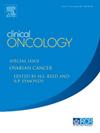Early Results of Hypofractionated Chemoradiation in Cervical Cancer with 44 Gy/ 20 F vs 45 Gy/ 25 F: A Phase II, Open-Label, Randomised Controlled Trial (HYPOCx-iRex Trial)
IF 3
3区 医学
Q2 ONCOLOGY
引用次数: 0
Abstract
Aims
To compare the safety and efficacy of hypofractionated chemoradiation (HYPO) regimen with a conventional fractionation (CVRT) for locally advanced cervical cancer (LACC).
Materials and methods
A single-centre, open-label, randomised controlled trial enrolled patients with LACC to receive either HYPO (44 Gy/20 fractions) or CVRT (45 Gy/25 fractions) with intensity-modulated radiotherapy, image-guided adaptive brachytherapy, and concurrent weekly cisplatin. The primary outcome was the incidence of acute and late gastrointestinal (GI) and genitourinary (GU) toxicity assessed using the Common Terminology Criteria for Adverse Events version 5.0. Secondary outcomes included health-related quality of life (HRQoL), disease control, and survival.
Results
Forty patients with a median follow-up of 19 months were enrolled (HYPO: n=21; CVRT: n=19). The HYPO achieved a significantly shorter overall treatment time (OTT) compared with CVRT (39 vs 47 days, P < .001). GI and GU toxicities were manageable, with a trend towards higher rates in the HYPO compared with CVRT for both acute (grading [Gr]≥3 CTCAE/patient-reported outcome 43%/29% vs 32%/11%, P=.53/0.24) and actuarial 18-month late GI toxicity (Gr≥2/Gr≥3 26.2%/21.2% vs 20.6%/14.4%, P=.537/0.438), although not statistically significant. No Gr≥3 GU toxicity was observed. HRQoL scores during treatment were lower in the HYPO compared with CVRT; however, recovering within the 3-month post-radiotherapy period. A trend toward superior locoregional control was observed in the HYPO. Notably, para-aortic control at 24 months was significantly higher in the HYPO (100% vs 71.2%, P=.003). No significant differences were observed in local control or overall survival at the time of analysis.
Conclusion
HYPO with modern techniques is feasible for LACC, significantly reducing OTT. A trend towards higher yet tolerable acute and late GI toxicity warrants further investigation. Encouragingly, HYPO showed promising locoregional control.
Registration number
thaiclinicaltrials.org (TCTR20210812003)
44 Gy/ 20 F与45 Gy/ 25 F低分割放化疗在宫颈癌中的早期结果:一项II期、开放标签、随机对照试验(HYPOCx-iRex试验)
目的比较低分割放化疗方案(HYPO)与常规分割放化疗方案(CVRT)治疗局部晚期宫颈癌(LACC)的安全性和有效性。材料和方法一项单中心、开放标签、随机对照试验招募了LACC患者,接受HYPO (44 Gy/20分)或CVRT (45 Gy/25分),同时接受调强放疗、图像引导适应性近距离放疗和每周同步顺铂治疗。主要终点是急性和晚期胃肠道(GI)和泌尿生殖系统(GU)毒性的发生率,使用不良事件通用术语标准5.0版进行评估。次要结局包括健康相关生活质量(HRQoL)、疾病控制和生存。结果40例患者入组,中位随访19个月(HYPO: n=21; CVRT: n=19)。与CVRT相比,HYPO实现了更短的总治疗时间(OTT)(39天和47天,P < 001)。GI和GU毒性是可控的,与CVRT相比,在急性(分级[Gr]≥3 CTCAE/患者报告结果43%/29% vs 32%/11%, P= 0.53 /0.24)和精算18个月晚期GI毒性(Gr≥2/Gr≥3 26.2%/21.2% vs 20.6%/14.4%, P= 0.537 /0.438)中,HYPO的发生率有更高的趋势,尽管没有统计学意义。未见Gr≥3gu毒性。治疗期间,HYPO组HRQoL评分较CVRT组低;然而,在放疗后3个月内恢复。在HYPO中观察到一种向优越的局部区域控制的趋势。值得注意的是,24个月时,HYPO患者的主动脉旁控制率明显更高(100% vs 71.2%, P= 0.003)。在分析时,局部对照或总生存期未观察到显著差异。结论现代hypo技术治疗LACC是可行的,可显著降低OTT。更高但可耐受的急性和晚期胃肠道毒性的趋势值得进一步调查。令人鼓舞的是,HYPO显示出有希望的局部区域控制。注册编号:theicclinicaltrials.org (TCTR20210812003)
本文章由计算机程序翻译,如有差异,请以英文原文为准。
求助全文
约1分钟内获得全文
求助全文
来源期刊

Clinical oncology
医学-肿瘤学
CiteScore
5.20
自引率
8.80%
发文量
332
审稿时长
40 days
期刊介绍:
Clinical Oncology is an International cancer journal covering all aspects of the clinical management of cancer patients, reflecting a multidisciplinary approach to therapy. Papers, editorials and reviews are published on all types of malignant disease embracing, pathology, diagnosis and treatment, including radiotherapy, chemotherapy, surgery, combined modality treatment and palliative care. Research and review papers covering epidemiology, radiobiology, radiation physics, tumour biology, and immunology are also published, together with letters to the editor, case reports and book reviews.
 求助内容:
求助内容: 应助结果提醒方式:
应助结果提醒方式:


